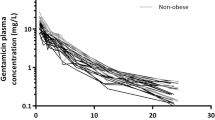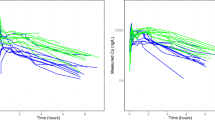Abstract
Background and Objectives: In a previous article, we showed that the pharmacokinetic set of remifentanil used for target-controlled infusion (TCI) might be biased in obese patients because it incorporates flawed equations for the calculation of lean body mass (LBM), which is a covariate of several pharmacokinetic parameters in this set. The objectives of this study were to determine the predictive performance of the original pharmacokinetic set, which incorporates the James equation for LBM calculation, and to determine the predictive performance of the pharmacokinetic set when a new method to calculate LBM was used (the Janmahasatian equations).
Methods: This was an observational study with intraoperative observations and no follow-up. Fifteen morbidly obese inpatients scheduled for bariatric surgery were included in the study. The intervention included manually controlled continuous infusion of remifentanil during the surgery and analysis of arterial blood samples to determine the arterial remifentanil concentration, to be compared with concentrations predicted by either the unadjusted or the adjusted pharmacokinetic set. The statistical analysis included parametric and non-parametric tests on continuous variables and determination of the median performance error (MDPE), median absolute performance error (MDAPE), divergence and wobble.
Results: The median values (interquartile ranges) of the MDPE, MDAPE, divergence and wobble for the James equations during maintenance were −53.4% (−58.7% to −49.2%), 53.4% (49.0–58.7%), 3.3% (2.9–4.7%) and 1.4% h−1 (1.1–2.5% h−1), respectively. The respective values for the Janmahasatian equations were −18.9% (−24.2% to −10.4%), 20.5% (13.3–24.8%), 2.6% (−0.7% to 4.5%) and 1.9% h−1 (1.4–3.0% h−1). The performance (in terms of the MDPE and MDAPE) of the corrected pharmacokinetic set was better than that of the uncorrected one.
Conclusion: The predictive performance of the original pharmacokinetic set is not clinically acceptable. Use of a corrected LBM value in morbidly obese patients corrects this pharmacokinetic set and allows its use in obese patients. The ‘fictitious height’ can be a valid alternative for use of TCI infusion of remifentanil in morbidly obese patients until commercially available infusion pumps and research software are updated and new LBM equations are implemented in their algorithms.











Similar content being viewed by others
References
Obesity: preventing and managing the global epidemic: report of a WHO consultation. World Health Organ Tech Rep Ser 2000; 894: i–xii, 1-253
Adams JP, Murphy PG. Obesity in anaesthesia and intensive care. Br J Anaesth 2000; 85: 91–108
Agarwal N, Shibutani K, SanFilippo JA, et al. Hemodynamic and respiratory changes in surgery of the morbidly obese. Surgery 1982; 92: 226–34
Alexander JK. Obesity and circulation. Mod Concepts Cardiovasc Dis 1963; 32: 799–803
Henegar JR, Bigler SA, Henegar LK, et al. Functional and structural changes in the kidney in the early stages of obesity. J Am Soc Nephrol 2001; 12: 1211–7
Minto CF, Schnider TW, Egan TD, et al. Influence of age and gender on the pharmacokinetics and pharmacodynamics of remifentanil: I. Model development. Anesthesiology 1997; 86: 10–23
James WPT, Waterlow JC. UK Department of Health and Social Security/Medical Research Council Group on Obesity Research. Research on obesity: a report of the DHSS/MRC Group. London: Her Majesty’s Stationery Office, 1976
La Colla L, Albertin A, La Colla G. Pharmacokinetic model-driven remifentanil administration in the morbidly obese: the ‘critical weight’ and the ‘fictitious height’, a possible solution to an unsolved problem? Clin Pharmacokinet 2009; 48(6): 397–8
Janmahasatian S, Duffull SB, Ash S, et al. Quantification of lean bodyweight. Clin Pharmacokinet 2005; 44: 1051–65
La Colla L, Albertin A, La Colla G, et al. Target controlled infusion of remifentanil: beware when using it in morbidly obese patients. First World Congress of Total Intravenous Anesthesia — TCI; 2007 Sep 27–29; Venice
Bossu E, Montinaro A, Lecce R, et al. LC-MS determination of remifentanil in maternal and neonatal plasma. J Pharm Biomed Anal 2006; 42: 367–71
TIVAtrainer© version 5.1 [computer program; online]. Available from URL: http://www.eurosiva.org/TivaTrainer/tivatrainer_main.htm [Accessed 2009 Nov6]
Rugloop© version 3.28 [computer program; online]. Available from URL: http://www.demed.be/rugloop.htm [Accessed 2009 Nov 6]
Varvel JR, Donoho DL, Shafer SL. Measuring the predictive performance of computer-controlled infusion pumps. J Pharmacokinet Biopharm 1992; 20: 63–94
Miller RD, editor. Anesthesia. 6th ed. New York: Churchill Livingstone, 2006
Schuttler J, Kloos S, Schwilden H, et al. Total intravenous anaesthesia with propofol and alfentanil by computer-assisted infusion. Anaesthesia 1988; 43 Suppl.: 2–7
Mertens MJ, Engbers FH, Burm AG, et al. Predictive performance of computer-controlled infusion of remifentanil during propofol/remifentanil anaesthesia. Br J Anaesth 2003; 90: 132–41
Green B, Duffull S. Caution when lean body weight is used as a size descriptor for obese subjects. Clin Pharmacol Ther 2002; 72: 743–4
Egan TD, Huizinga B, Gupta SK, et al. Remifentanil pharmacokinetics in obese versus lean patients. Anesthesiology 1998; 89: 562–73
Janmahasatian S, Duffull SB, Chagnac A, et al. Lean body mass normalizes the effect of obesity on renal function. Br J Clin Pharmacol 2008; 65: 964–5
Mertens MJ, Olofsen E, Burm AG, et al. Mixed-effects modeling of the influence of alfentanil on propofol pharmacokinetics. Anesthesiology 2004; 100: 795–805
Vuyk J, Engbers FH, Burm AG, et al. Performance of computer-controlled infusion of propofol: an evaluation of five pharmacokinetic parameter sets. Anesth Analg 1995; 81: 1275–82
Acknowledgements
These data were presented in part at the 2008 Congress of the Società Italiana di Anestesia Analgesia Rianimazione e Terapia Intensiva (Palermo, Italy; 14–17 October 2008). Support for this work was provided solely from institutional/departmental sources. The authors want to thank Daniele Pinna, MSc, from the Department of Physics at New York University (New York, NY, USA) for his help during the revision process. The authors have no conflicts of interest that are relevant to the contents of this study.
Author information
Authors and Affiliations
Corresponding author
Rights and permissions
About this article
Cite this article
La Colla, L., Albertin, A., La Colla, G. et al. Predictive Performance of the ‘Minto’ Remifentanil Pharmacokinetic Parameter Set in Morbidly Obese Patients Ensuing from a New Method for Calculating Lean Body Mass. Clin Pharmacokinet 49, 131–139 (2010). https://doi.org/10.2165/11317690-000000000-00000
Published:
Issue Date:
DOI: https://doi.org/10.2165/11317690-000000000-00000




